Cultural Exchange in Cuba
Tom, a Boy Scout Leader who served with his troop in Ciego de Avila, writes about their people-to-people cultural exchange in Cuba:
No alarm clock rang as the sun streamed through the curtains. Did we oversleep? After waking early for the past 5 days we all slept in late today. Breakfast was at a slower Cuban pace as omelettes, meats and fruit were enjoyed by all. Today was to be another adventure in our exciting Cuban volunteer excursion. Today was about cultural exchange in Cuba.
We started the morning’s transportation in a AC cooled bus that wove it way through the streets to the Ciego de Avila Library. We were greeted by Eduardo who explained the building was a school that is converted to its present use. We saw the children’s portion then we’re led to a auditorium where we were treated to a performance by the group Rumbavila, a popular national awarding winning troupe of Afro-Cuban jaundra. As they preformed they invited the boys on stage to play an dance with them. Soon everyone was on there feet. Cubans place high value on their culture and the arts. It obviously drew our two cultures together as it does worldwide. Eduardo explained the Spanish conquered Cuba. After the indigenous population gone, slaves were brought over as a workforce and converted to Catholicism. The slaves hid there beliefs behind the Catholic saints and over time melded creating the most practiced religion in Cuba, Santeria.
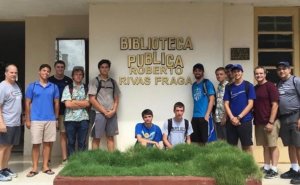
The Scouts Troop stop at the Library in Ciego de Avila, one of the weekend people-to-people cultural points of interest in Cuba.
Next we traveled to the town of Moron, a smaller community about an hour north on a lake close to the coast. Our first stop was lunch at Rancho Palma. The restaurant doubles as an animal display from rabbits to guinea pigs to roosters to jutia. As always, we enjoyed a delicious meal; this time island style, open air, under thatched roofs.
A short bus ride through town took us to the Regero Theater (and school) in Moron, Circa 1922. It was renovated 10 years ago mainly through manual labor. Our host, Orlando Concepcion pointed out a special attribution of this theater is to live in and hold a 10 day event twice a year in a deprived community. This is a part of a government planned project to help develop underprivileged communities. The theater put on a variety show consisting of comic plays, dancing, singing and aerobatics. We were all invited at one point or another to be the butt of a comic skit. Orlando then provided a question and answer session where we engaged in culture differences and similarities. We ended by being on stage with the choreographer who taught us salsa and Congo dance moves.
A short bus ride around the block and we picked up Larry. He has a PhD in history with interest in Latin America history. Moron is named after a town in Spain. They had a very bad guy who walked around like a Rooster. The mayor built a statue after him which became the symbol of the town. That symbol was built in the Moron Cuba also. Our next stop was the lake just outside of town. About 7 by 3 miles of fresh water. A few fishing boats, but mostly local tourist. We relaxed at a restaurant on pilings 20 yards off shore after traversing a concrete bridge. Pleasant conversation started quickly covering a wide range of topics.
“As a group I can tell we are asking more and more sensitive questions which the Cubans are more than happy to answer openly and honestly. They are sincere in wanting no misconceptions.”

A woman practicing Santeria in Cuba.
Larry invited us to his home where a band was awaiting and played America and Cuban music. In between he explained more Cuban culture and customs. One custom he is starting is “sitting in the hammock”. The hammock is a Cuban Caribbean invention. Who ever sits must answer questions from anyone in the group. Larry did all this for us on his birthday.
A short ride to dinner (chicken or pork) was typical Cuban. Salt but little herbs and never peppered. But delicious just the same. The owner, Don Papa, made sure we were treated well. The meal was served with white and brown rice, potatoes, plantain chips, and vegetables. It is a custom for this restaurant to have 4 musicians playing guitar, bongos and singing while you eat for tips. Traditional Cuban desert is flan, unusual for most Americans, but consumed in full just the same.
A few observations. 1 out of 10 cars are 1950s American classics. Not cherried out but just old and maintained. Major mode of transportation is walking, biking, small motorcycle or mopeds (some electric), cars, Horse and buggy in that order. 90+% of electrical telephone poles are cement. Many sign post are also cement. I feel very safe here and would expect the crime rate to be very low. Our hotel feels very safe to leave our valuables in.
An hour’s ride back in the bus returns us to our temporary home, the Ciego de Avila Hotel, and rest for weary travelers. It was a long day of cultural exchange in Cuba.
“As my head hit the pillow, the bed never felt so good after a day of learning, understanding and fun.”
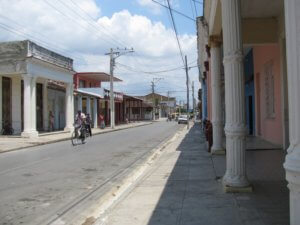
The streets of Ciego de Avila, Cuba.



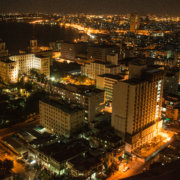
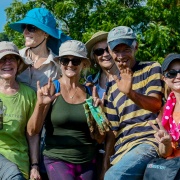
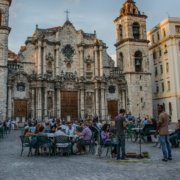
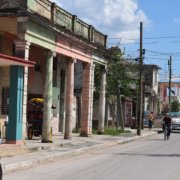


Leave a Reply
Want to join the discussion?Feel free to contribute!